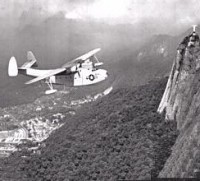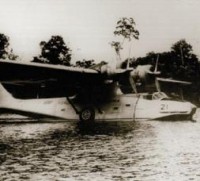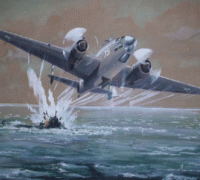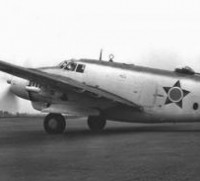- ANTI SUBMARINE TACTICS
14LOCKHEED PV1 VENTURA
Ceremony of PV 1 Ventura being delivered to Brazilian Air Force at Recife Ibura field 1944. 14 were employed in Brazilian first Medium bomber squadron based at Recife late in 1943 and replaced US Navy Squadrons VB 130 and VB 143. As the Brazilian Armed Forces took over more of their own coastal protection, the U.S. transferred ASW aircraft. Photo NARS.
Lockheed Ventura is a twin-engine medium bomber and patrol bomber of World War II.
The Ventura first entered combat in Europe as a bomber with the RAF in late 1942. Designated PV-1 by the United States Navy (US Navy), it entered combat in 1943 in the Pacific. The bomber was also used by the United States Army Air Forces (USAAF), which designated it the Lockheed B-34 (Lexington) and B-37 as a trainer. British Commonwealth forces also used it in several guises, including antishipping and antisubmarine search and attack.
The Ventura was developed from the Lockheed Model 18 Lodestar transport, as a replacement for the Lockheed Hudson bombers then in service with the Royal Air Force. Used in daylight attacks against occupied Europe, they proved to have weaknesses and were removed from bomber duty and some used for patrols by Coastal Command. After USAAF monopolization of land-based bombers was removed, the US Navy ordered a revised design which entered service as the PV-2 Harpoon for anti-submarine work.
Lockheed Ventura/B-34 Lexington
At the start of the war, Lockheed proposed military conversions of the Lodestar for the RAF as replacement for the Hudson reconnaissance aircraft and the Bristol Blenheim bomber. The first British order was placed in February 1940 for 25 Model 32 as bombers. This was followed by an order for 300 Model 37 with Double Wasp engines, then for a further 375 later in 1940. Lockheed needed more production capacity and The nearby Vega Aircraft Corporation was contracted for building the Ventura.
The Ventura was very similar to its predecessor, the Lockheed Hudson. The primary difference was not in layout; rather, the Ventura was larger, heavier, and used more powerful engines than the Hudson. The RAF ordered 188 Venturas in February 1940, which were delivered from mid-1942. Venturas were initially used for daylight raids on occupied Europe but, like some other RAF bombers, they proved too vulnerable without fighter escort, which was difficult to provide for long-range missions. Venturas were replaced by the faster de Havilland Mosquito.
The Venturas were transferred to patrol duties with Coastal Command as the Mosquito replaced them in bomber squadrons; 30 went to the Royal Canadian Air Force (RCAF) and some to the South African Air Force (SAAF). The RAF placed an order for 487 Ventura Mark IIs but many of these were diverted to the USAAF, which placed its own order for 200 Ventura Mark IIA as the B-34 Lexington, later renamed RB-34.
Lockheed B-37
In August 1941, large orders for Venturas were placed with Lend-Lease Act money. Among the orders were for 550 armed reconnaissance versions of the Ventura. This aircraft was originally planned to be built under the designation O-56. The main differences between the Ventura and the O-56 were in the engines: rather than the 2,000 hp (1,491 kW) Pratt & Whitney R-2800 radials of the Ventura, the O-56 used 1,700 hp (1,270 kW) Wright R-2600-13 radials.
Before completion of the first O-56, the U.S. Army Air Forces dropped the "O-" category used to designate "observation" (reconnaissance) aircraft. The O-56 was redesignated the RB-34B (the R denoted 'restricted' meaning it was not to be used for combat). Before the first of these flew, the design was redesignated again as the B-37 with a higher powered version of the R-2600, later it also was designated the RB-37.While 550 were ordered by the Army Air Forces, acquisition by the USAAF stopped after only 18 Venturas were accepted, when the Army Air Forces agreed to turn over exclusive use of the Ventura to the United States Navy.
PV-1 Ventura
The PV-1 Ventura, built by the Vega Aircraft Company division of Lockheed (hence the "V" Navy manufacturer's letter that later replaced the "O" for Lockheed), was a version of the Ventura built for the U.S. Navy (see Venturas in U.S. Navy service below). The main differences between the PV-1 and the B-34 were the inclusion of special equipment in the PV-1, adapting it to its patrol bombing role. The maximum fuel capacity of the PV-1 was increased from 1,345 gal (5,081 l) to 1,607 gal (6,082 l), to increase its range; the forward defensive armament was also reduced for this reason. The most important addition was of an ASD-1 search radar.
Early production PV-1s still carried a bombardier's station behind the nose radome, with four side windows and a flat bomb-aiming panel underneath the nose. Late production PV-1s dispensed with this bombardier position and replaced it with a pack with three 0.50 inch (12.7 mm) machine guns underneath the nose. These aircraft could also carry eight 5-inch (127 mm) HVAR rockets on launchers underneath the wings.
The PV-1 began to be delivered in December 1942, and entered service in February 1943. The first squadron in combat was VP-135, deployed in the Aleutian Islands in April 1943. They were operated by three other squadrons in this theatre. From the Aleutians, they flew strikes against bases in Paramushiro and Shimushu, Japanese islands in the Kurile chain. Often, PV-1s would lead B-24 bomber formations, since they were equipped with radar. In late 1943, some PV-1s were deployed to the Solomon Islands as night fighters with VMF(N)-531, a Marine Corps fighter squadron.
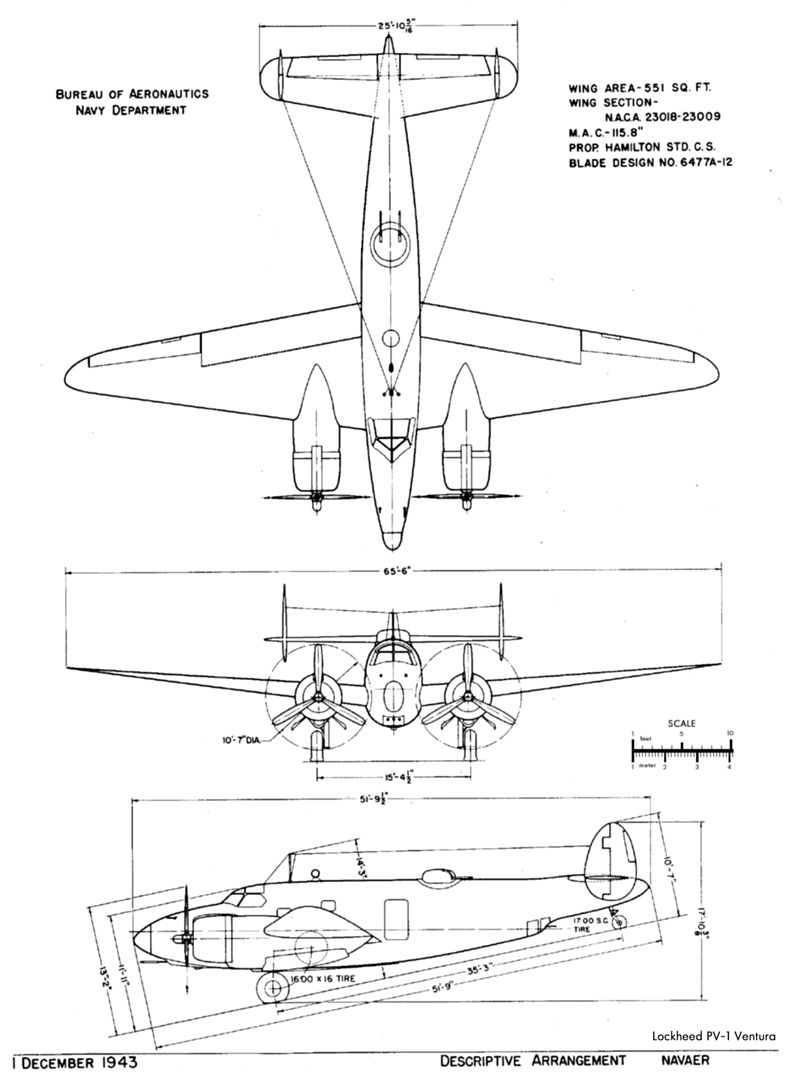
General characteristics
Crew: 6
Length: 51 ft 5 in (15.7 m)
Wingspan: 65 ft 6 in (20 m)
Height: 11 ft 10 in (3.6 m)
Wing area: 551 sq ft (51.2 m2)
Empty weight: 20,197 lb (9,161 kg)
Gross weight: 31,000 lb (1,461 kg)
Max takeoff weight: 34,000 lb (15,422 kg)
Powerplant: 2 × Pratt & Whitney R-2800 radial engines, 2,000 hp (1,500 kW) each
Performance
Maximum speed: 322 mph (518 km/h, 280 kn)
Cruise speed: 230 mph (370 km/h, 200 kn)
Range: 1,660 mi (2,670 km, 1,440 nmi)
Ferry range: 2,600 mi (4,200 km, 2,300 nmi)
Service ceiling: 26,300 ft (8,020 m)
Rate of climb: 2,035 ft/min (15.4 m/s)
Wing loading: 56.4 lb/sq ft (275 kg/m2)
Power/mass: 0.13 hp/lb (0.21 kW/kg)
Armament
Guns:
4 × .50 BMG (12.7 mm) Browning M2 machine guns
2 × .30 cal. (7.62 mm) M1919 Browning machine guns
Bombs:
3,000 lb (1,400 kg) general ordnance or 6 × 325 lb (147 kg) depth charges or
1 × torpedo
https://en.wikipedia.org/wiki/Lockheed_Ventura

